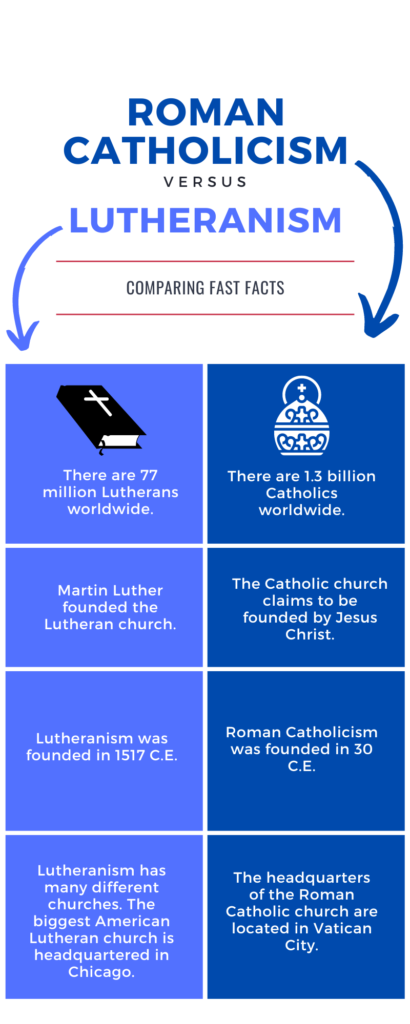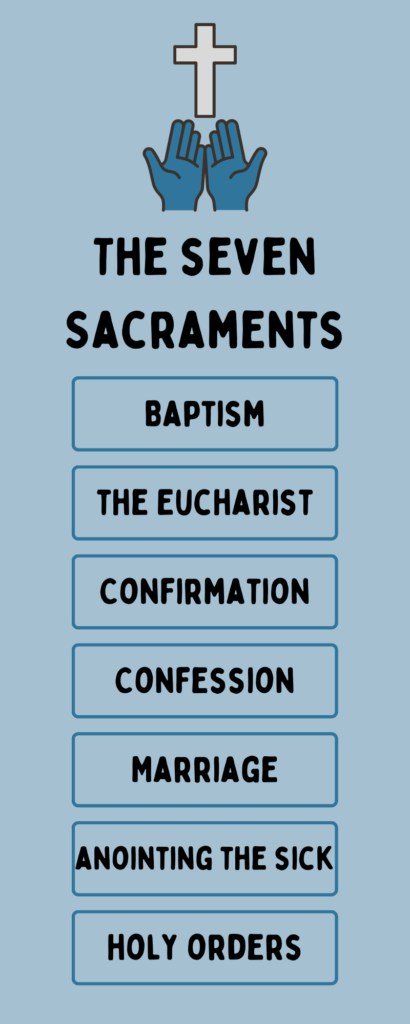
The roots of the Roman Catholic Church and the Lutheran Church are captivatingly interwoven. You will find out the histories of these two churches and explore the differences and commonalities between them.
They have many significant differences in doctrine, including requirements for salvation, regard for the Virgin Mary, and governing bodies. Shared beliefs include the Trinity, end times, and the Apostles and Nicene creeds.
Comparison Between Roman Catholicism and Lutheranism

History and Governance: Roman Catholicism
Roman Catholicism is one of the three branches of Christianity, alongside Eastern Orthodox and Protestantism.
There are more Roman Catholic members (1.3 billion) than all other branches of Christianity combined. Talk about a world religion!
You can find elements of the Roman Catholic religion, particularly the early church, in the New Testament. The Catholic church claims that the church today is an extension of Jesus Christ’s church at the time of his life.
Catholic Authority
In the 2nd century C.E., St. Irenaeus created a system for judging authority to stick with the foundational teachings of the original church. Catholic theologians use these three criteria to determine whether scriptures were genuinely written by apostles.
For example, a claim from one criterion must be validated by the other two.
- New Testament and Old Testament scriptures
- Episcopal centers that were founded by the Apostles in the church government (located in Alexandria, Antioch, Jerusalem, and Rome)
- Traditional doctrine as used by the apostles (also known as the “rule of faith”)
The Bishop of Rome, also known as the Pope, is the sole successor of the priesthood of St. Peter, according to Catholic tradition. In the centuries following the life and death of Christ, the Catholic church spread with the early Roman Empire.
Catholic Growth
Until Christianity was legalized by Constantine I in 313 C.E., Christians were heavily persecuted. Then, just 67 years later, Christianity became the state religion of the Roman Empire. Over the next hundreds of years, the Roman Catholic church stood the test of time, fighting and winning battles with its neighbors.
Finally, in the 16th century and onward, the Church underwent reformation but persevered despite growing deserters of the faith, which included the early Lutherans.
History and Growth: Lutheranism
Now you can see where Lutheranism fits into the puzzle of the worldwide history of Christianity. The Lutheran church was part of the movement to reform the Roman Catholic church. It began in the 16th century when Martin Luther, a theologian, called for discussion of many issues of the Catholic church.
Then, Lutheranism became a prominent religious and political movement within the Roman Empire. Factors like the ongoing Renaissance, the emergence of widespread literacy, and printing presses aided the early Lutheran church.
In Germany, in 1517, Martin Luther disputed certain Roman Catholic church practices in his article “Ninety-Five These.” In 1546, Luther allegedly sparked the Protestant Reformation by nailing this very article to a church door.
Within two months, Luther’s list of disputes had been translated and printed throughout Europe. Finally, after a wild ride of back-and-forth communications between Luther’s side and that of the Pope, Luther was excommunicated from the Roman Catholic church in 1521.
Today, the Lutheran church claims 77 million members worldwide.
Similarities Between Roman Catholics and Lutherans
Since the Lutheran church originated in the Roman Catholic church, they share some commonalities. In general, both churches trace back to the life and teachings of Jesus Christ in Palestine around 30 C.E.
- Apostles Creed and Nicene Creed
- These creeds are stanzas proclaiming Christians’ standard beliefs. Catholicism accepts more creeds than these two, while Lutheranism only accepts these two.
- Ecumenical Councils
- Ecumenical councils are church bishopric meetings. These meetings resolved specific questions about Christian doctrine. Catholicism accepts all 21 historical ecumenical councils, while Lutheranism accepts only the first seven. Some Lutheran churches only accept the first four. This means that Lutheranism rejects many of the ideologies proposed in the latter ecumenical councils.
- End Times (Amillennialism)
- Both churches believe that the end of times will come when Christ returns. The book of Revelation prophesies that this would have been 1,000 years after Christ’s life and death. However, both churches believe that the 1,000-year prophecy is only figurative and not literally 1,000 years.
- Trinity
- Lutherans and Roman Catholics are Trinitarian, meaning the Father and Son are two distinct figures. The Holy Spirit is the third party that emits from the Father and Son. Subsequently, members of both faiths worship the Trinity as one deity.
- Original Sin
- Both religions believe in the principle of original sin, meaning that every human born is inherently tainted with evil due to Adam and Eve’s first sin.
MORE:
- Gods & Goddesses of Death
- Are Adam And Eve In Heaven Or Hell
- Catholic vs. Protestant
- Church True Meaning
- Bible about Circumcision
Differences Between Roman Catholics and Lutherans
Below is a side-by-side comparison of some of the most integral aspects of these two religions.
| Topic | Roman Catholicism | Lutheranism |
|---|---|---|
| Scriptural Importance | Doctrinal authority comes from apostolic tradition, episcopal centers, and the Bible. | The Bible is the only doctrinal authority. |
| Mary | Catholics believe Mary, as a virgin, gave birth to Jesus Christ, known as immaculate conception. The Catholic church teaches that Mary is the most dignified among saints and was born without sin. Lutherans do not believe this. Catholics believe in perpetual virginity, meaning Mary was a virgin before, during, and after the birth of Christ. Many Catholic popes have given tribute to Mary as the Queen of Heaven, the Mother of the Church, and a mediator to God (the most influential mediator among saints). Therefore, members pray to Mary. | Lutherans believe Mary, as a virgin, gave birth to Jesus Christ, known as immaculate conception. Lutherans do not pray to Mary or give her any other notable titles. |
| Stance on Evolution | The only statement the Roman Catholic church made about evolution is that the current scientific findings and church doctrine do not necessarily conflict. Catholics generally accept evolutionary theory. | The Evangelical Lutheran Church in America professes that evolution might have been God’s creation methodology, so it doesn’t conflict with their scriptural teachings. Some Lutheran churches reject Darwinian evolution, like the Lutheran Church-Missouri Synod. |
| Salvation | The Roman Catholic church does not preach this. Instead, they believe works are necessary for salvation. | Martin Luther taught that God saves all people through grace through faith in Jesus Christ through justification. In other words, God’s grace does the saving. |
| Sacraments | Roman Catholics believe that Jesus Christ instituted each of their seven sacraments. They believe Jesus ordained the first pope, St. Peter (in the Bible, see Matthew 16:18). | Lutherans follow two of the seven sacraments: baptism and confession. |
| Communion | Catholics believe in transubstantiation, meaning the wine and bread of communion transform into the Lord’s blood and flesh after consuming them. | They believe that Christ’s body and blood are physically present during communion. Lutherans also confess and reflect on their lives before accepting the Lord’s Supper. |

Identifying Doctrine of Lutheranism
The primary and identifying doctrine of the Lutheran church is justification, meaning humans are saved through God’s grace alone. In other words, humans can do all the good deeds they want, but it will never satisfy God, so His grace is necessary.
Lutherans baptize both infants and adults, believing the act pleases God and offers sanctification by the Holy Spirit.
Identifying Doctrine of Catholicism
The pope and his office (the papacy) is the most notable distinguishing factor of Catholicism. The pope is the church’s highest authority, and Catholics believe that he has the priesthood directly tracing back to St. Peter, Jesus’ apostle.
Before baptizing an infant, the Catholic priest will ask the parents and godparents to recite the Apostles’ Creed to ensure the baby will be raised in good faith.
The seven sacraments (baptism, the eucharist, confirmation, confession, marriage, anointing of the sick, and holy orders) are also unique to the Catholic faith.
MORE:
- Greek Gods & Goddesses
- Release Rage
- Holy Spirit
- How Long Should You Wait After Death For The Funeral
- How Soon After Death Do You Go To Heaven
